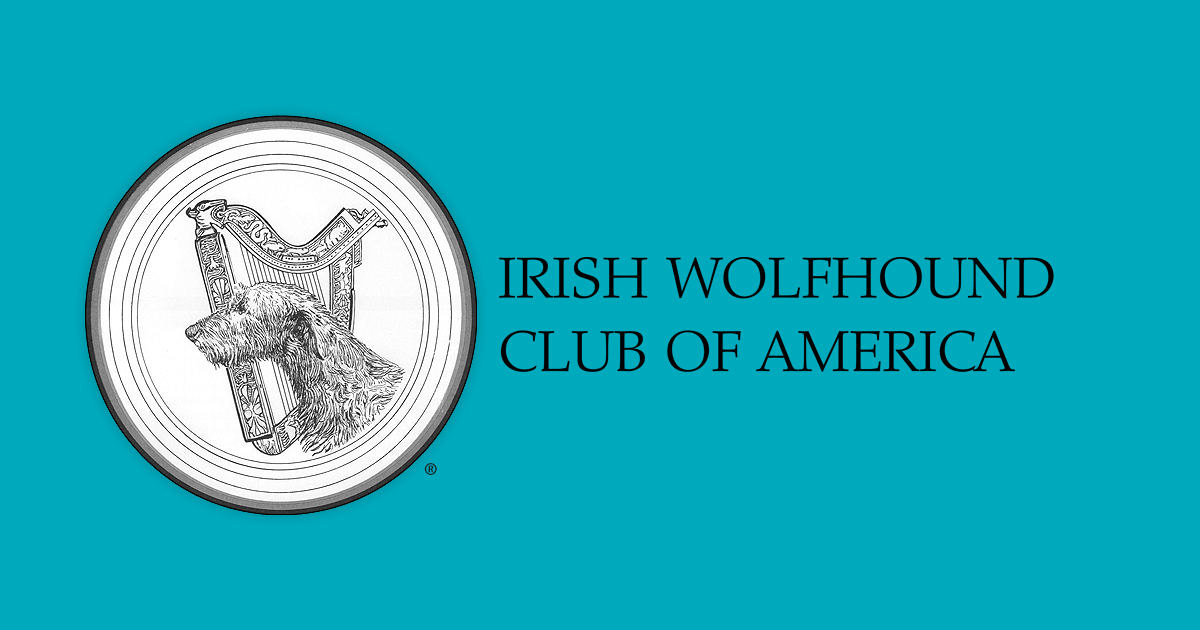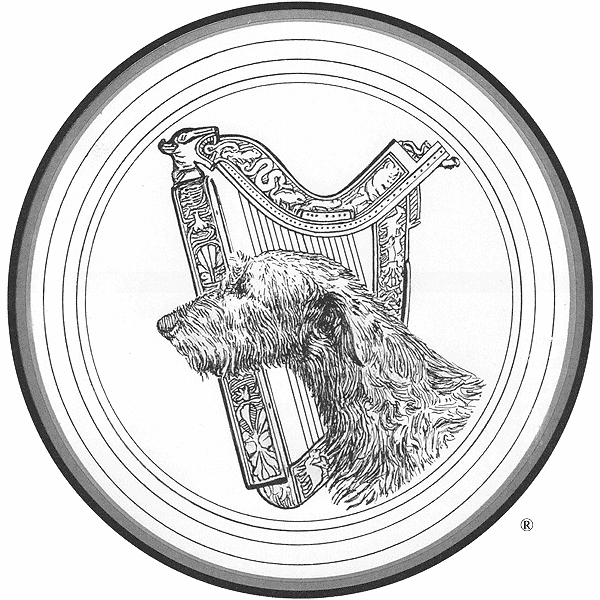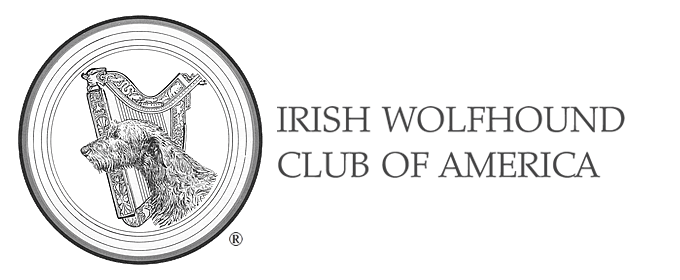Early History of the Breed
From The Complete Irish Wolfhound, Revised Edition (2nd)
The story of the Irish Wolfhound, "like all Gaul," may be divided into three parts: the data regarding the ancient wolfdog with his romantic historical background; the extraordinary feat of Captain G.A. Graham in reviving the breed in the nineteenth century; and the dog among us today.
Though the Wolfhound's origin is lost in antiquity, he is famous both in legends and in the written pages of history.
Arrian, writing in the second century A.D., mentions that swift Hounds were brought to Greece during the invasion of the Celts, who sacked Delphi in 273 B.C. Evidence of this is borne out by statues, jewelry, and paintings which are described in detail, and some of which have been recovered along with other artifacts of the period.
One of the woodcuts by Phyllis Gardner is from a picture of a fresco at Tiryns in Northern Greece, and shows a man with a pair of horses and a dog. Miss Gardner says the artists of this period were given to fairly accurate representations and the scale of the man and horses is reasonable; yet, the highest part of the dog's back is nearly up to the man's waist, while the tip of the dog's ear is actually level with the man's shoulders. The Hound in this picture is of Greyhound type, though enormous, and is of good weight and power.
To Father Edmund Ignasius Hogan, S.J., is due the credit of much of the information concerning the Irish Hound. Father Hogan devoted years of a busy life searching modern and ancient classics for all references to this great Hound and evidences of his character, size, and appearance. He published his findings in Dublin in 1897 in a monograph he called THE IRISH WOLFDOG, but a disastrous fire destroyed almost the entire edition. Only a few copies were saved and Father Hogan was unable to have the book reprinted. About ten years later, Joseph A. McAleenan of Long Island, a sportsman and lifelong friend of the dogs of Ireland, had two hundred copies printed privately. Some of these were presented to friends, others found their way into libraries.
Mr. McAleenan says, "I believe this, the only authoritative book on the subject, will excite interest and be the means of spreading an intimate knowledge of a dog that typifies the greatest in stature, intelligence, courage, loyalty, and affection of all the dog family."
In the preface of his books, Father Hogan writes, "To the blessed Edmund Campion, S.J., we owe the first description of the form, size and use of the great Irish Greyhound. In the year 1571 he wrote at Turvey, near Dublin: "The Irish are not without wolves and greyhounds to hunt them, bigger of bone and limb than a colt." In the light of these words we understand that "his" big wolf-hunting greyhounds were identical in breed with "the Irish dogs," "big dogs of Ireland," "Greyhounds of Ireland," "Wolfdogs of Ireland," which were sent as highly prized presents to Roman consuls; to Kings of England, Scotland, France, Spain, Sweden, Denmark and Poland; to Emperors, Great Moguls, Grand Turks, the Shahs of Persia; Ambassadors, Papal Nuncios, French Princes and Dutch Noblemen; to Prime Ministers, Noblemen and highborn beauties in Great Britain."
The breed was well known in Roman days. The first authentic record was made in A.D. 391 when the Roman Consul, Quintus Aurelius Symmachus, mentions them in a letter to his brother, Flavianus, in thanking him for a gift of Irish dogs which he had contributed to their solemn "Shows and Games," saying, "All Rome viewed them in wonder." The dogs sent to Symmachus were seven in number -- the usual number presented by one king or chief to another.
The Irish Wolfhound was the most valued and sought after hunting dog of the early centuries, not only because of his hunting prowess but because he was an exceptional guardian and companion.
We read of Cu-Chulainn, the bravest hero of the Irish in the first century of our era, who derived his name from an incident of his youth, writes Miss Gardner. I quote: "As he approached to the house of the smith Culann, the great hound that was Culann's guardian set upon him and in the ensuing struggle he slew it -- no mean feat for a boy of fifteen. He was overcome with remorse and offered to take the place of the slain hound for a year, while he should train a pup of its begetting. His name up to this time had been Setanta, but he is much better known as Cu-Chulainn, "the Hound of Culann.""
Father Hogan says the admiration and love of the Irishmen for their Greyhound is evidenced by the fact that Cu (Greyhound) or Mil-Chu (Greyhound that hunted large game) was part of the name of many chieftains and warriors.
Cu-Chulainn says to himself:
"I was a greyhound (Cu) of catching a deer, I was a greyhound strong for combat, I was a greyhound of visiting troops..."
About the third or fourth century there flourished the mighty warrior and huntsman, Finn, son of Cumall, celebrated in the cycles of the poet Oisin. Finn was chief of the household of King Cormac, commander of the armies and master of his Hounds. We are told his Hounds numbered three hundred and his puppies, two hundred. Finn had a favorite Hound named Conbec, and not in all Ireland might any stag whatsoever, at which he was slipped, find covert before Conbec would head him off and run him right back up to Finn's main pack, and to their attendants. And it is said that neither did Hound other than Conbec "ever sleep in the one bed with Finn." At Traig Chonbicce, Conbec was drowned by Goll, a rival of Finn, and on him Cailte, a warrior serving Finn, uttered the lay:
"Piteous to me was Conbec's cruel death, Conbec of perfect symmetry,
I have not seen a more expert of foot In the wake of wild boar or stag.
A pang to me was Conbec's tragic fate, Conbec of the hoarse deep voice;
Never have I seen one more expert of foot At killing buck without delay.
A pang to me was Conbec's death, Over the high green billows,
His cruel death was a cause of strife,
His fate was most pitiful."
Fighting the Romans along Hadriann's Wall in Britain were bands of Scots and others from Northern Britain, who were known as Fianna. There are various descriptions of great hunts organized by the Fianna. They tell how the chiefs of heroes, with their Hounds, would take their places on commanding heights, while their followers with lesser dogs sought out and drove the game over a large area. When the game came in sight, the chiefs would slip their Hounds at it. Sometimes as many as two hundred stags would be taken in one hunt.
Miss Gardner writes, "Many hill-tops still bear names which mean the seat of such and such a hero, i.e., a place from which he conducted his hunting. Suidhe Fergus, in Arran, is a case in point, being a hill with a very wide view in the centre of a district full of Celtic legend. Finn is said to have conducted certain hunts from the top of Ben Edair (Howth) and there are many other "Finn's seats' in Ireland."
The powerful Irish dogs were used not only in hunting wolf, stag, and boar, but also in hunting the gigantic Irish elk which stood six feet at the shoulder. Some of the Hounds were to be found in Iceland in the early days, and also in Scandinavia, with the result that we find early Irish influence in the folk tales from those two cultures.
According to the SAGA OF THE BURNT NJAL, in the tenth century, Olaf, a Norwegian, son of an Irish princess, says to his friend, Gunnar, "I will give thee a hound that was given to me in Ireland; he is big and no worse than a stout man. Besides, it is part of his nature that he has a man's wit, and he will bay at every man that he knows to be thy foe, but never at thy friends. He can see, too, in any man's face whether he means thee well or ill, and he will lay down his life to be true to thee. This hound's name is SAMR."
After that Olaf speaks to the Hound: "Now shalt thou follow Gunnar, and do him all the service thou canst." The Hound went at once to Gunnar, and laid himself down at his feet. Later, history relates, when Gunnar's enemies plotted to kill him, they found it necessary to kill the Irish Hound first.
King John of England presented an Irish Hound to Llewellyn, Prince of Wales, about the year 1210. A dog of this breed is referred to thus, in the Hon. W.R. Spencer's verses on Beth Gelert:
"The flower of all the race,
So true, so brave -- a lamb at home,
A lion in the chase.
'Twas only at Llewellyn's board
The faithful Gelert fed.
He watched, he served, he cheered his lord,
And sentinelled his bed.
To sooth he was a peerless hound,
The gift of Royal John."
The poem goes on to tell how Gelert killed a gaunt wolf and so saved his master's child.
A curious old manuscript from the twelfth century, mentions a certain Mesrodia, King of Leinsternien, who had a Wolfhound named Aibe, whose fame filled all Ireland. For this Hound six thousand cows and various other possessions were offered by the King of Connacht. At that, the King of Ulster made approximately the same offer. Feeling ran so high over the dog that the kings and their retainers betook themselves to their swords and a mighty battle ensued. History does not relate who won the dog.
There are many references to the Hound in Spain. In 1596 the great Spanish poet, Lope de Vega, wrote a sonnet on the Irish Wolfhound, in which he describes one surrounded by an army of curs, barking at him, and says:
"This high born greyhound, without heeding them, Lifted his leg, wet the projecting angle of the wall,
And through the midst of them went on quite at his ease."
From the twelfth to the sixteenth centuries hunting continued to occupy the attention of the Irish nobles and their chieftans, and their Wolfhounds continued to aid in their great hunts. By the seventeenth century, due to the disappearance of the wolves and elk and the steady depletion of the breed resulting from excessive exportation, a serious shortage of Wolfhounds became apparent in their native land -- so much so that an order was passed at a Parliament sitting in Kilkenney in 1652, prohibiting all persons from exporting them.
Some years ago Fredson T. Bowers wrote in the GAZETTE:
"That the history of the Irish Wolfhound is by no means complete as yet is shown by a reference, previously unrecorded, which I recently came upon in a play by William Wycherley, "The Gentleman Dancing Master," published in 1672 in London. In this play a Spaniard and a Frenchman are satirically describing each other, and the Frenchman says to the Spaniard: "And your Spainish hose, and your nose in the air, make you look like a great, grizzled, long Irish greyhound reaching a crust from a high shelf, ha! ha! ha!"
"This is one of the most fruitful references I have read in the past. It comes at a time when the hound has just about finished his work of exterminating the Irish wolves, and before the period of his decline has set in. Therefore, the date is a date when the hound is in his full flower and relative purity of blood, and should be close to the type of the traditional ancient breed. With these considerations in mind, now note the specific words. The hound is "great," that is, he is a huge hound, as he is today and has always been. This word is most frequently in the mouths of older writers of the breed.
"The next word is "grizzled." Without a doubt this word describes the various colored hairs which go to make up the peculiar characteristic of the hound's color which we know as "brindle." Probably Wycherley means also that the total effect is grey, as a person's hair is described as grizzled when its color is changing. Most important, this grizzle is almost certainly to be applied only to a long coated dog; and Wycherley has in mind a hound of the present type.
"The next word is "long," a singularly appropriate word to describe the rangy conformation of the Wolfhound, especially when he is stretching -- as he is in the portrait here -- to his full height, and probably on his hind legs, to reach up to the high shelf. This last detail is of the highest interest, for it is meant to emphasize the especial size and length of the dog, in short his great reaching ability, as the most vivid simile Wycherley could employ. Every detail confirms a dog of the characteristics known today, and all are peculiarly pertinent to the special qualities in the hound as we have him at the present time."
This page was last updated 07/11/2021.



